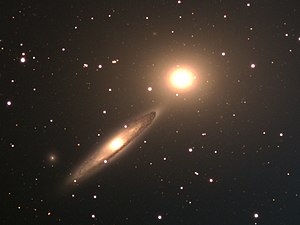NGC 5091
| Galaxy NGC 5091 |
|
|---|---|

|
|
| Galaxy pair NGC 5090 - 5091 | |
| AladinLite | |
| Constellation | centaur |
|
Position equinox : J2000.0 , epoch : J2000.0 |
|
| Right ascension | 13 h 21 m 17.7 s |
| declination | -43 ° 43 ′ 11 ″ |
| Appearance | |
| Morphological type | Sb pec sp |
| Brightness (visual) | 13.1 mag |
| Brightness (B-band) | 13.9 likes |
| Angular expansion | 1.8 ′ × 0.5 ′ |
| Position angle | 130 ° |
| Surface brightness | 12.8 mag / arcmin² |
| Physical data | |
| Affiliation |
NGC 5011 group NGC 5090 group LGG 339 |
| Redshift | 0.011771 ± 0.000484 |
| Radial velocity | 3529 ± 145 km / s |
|
Stroke distance v rad / H 0 |
(150 ± 12) · 10 6 ly (46.1 ± 3.8) Mpc |
| history | |
| discovery | John Herschel |
| Discovery date | June 3, 1834 |
| Catalog names | |
| NGC 5091 • PGC 46626 • ESO 270-004 • MCG -07-27-055 • 2MASX J13211859-4343244 • SGC 131823-4327.5 • GC 3497 • h 3488 • 2MASS J13211773-4343107 • LDCE 916 NED162 | |
NGC 5091 is a 13.1 mag bright spiral galaxy of the Hubble type Sb in the constellation Centaur in the southern sky . It is estimated to be 150 million light years from the Milky Way and about 90,000 light years in diameter. It probably forms an interacting galaxy pair with NGC 5090 .
The object was discovered on June 3, 1834 by John Herschel with an 18-inch reflector telescope, which "very faint, round, 20 arcseconds. The last of four ”noted. The other galaxies in this group are NGC 5082 , NGC 5086, and NGC 5090 .
